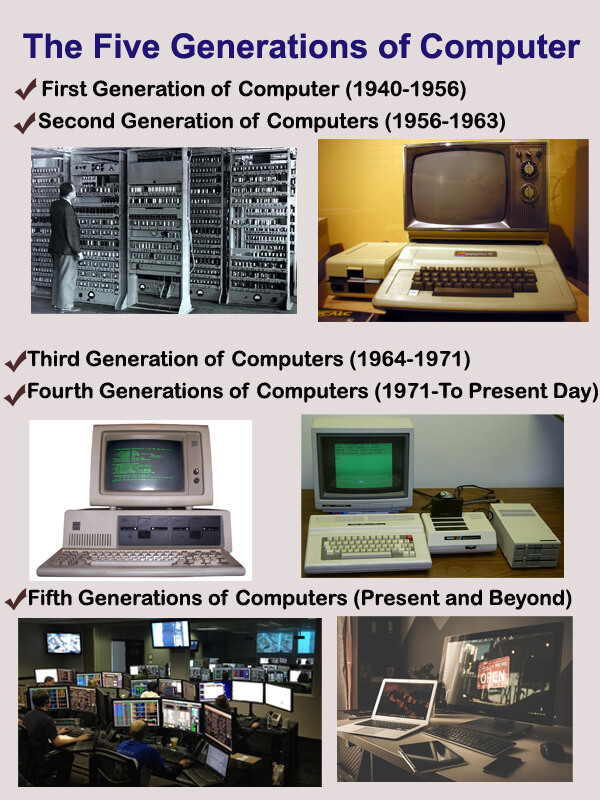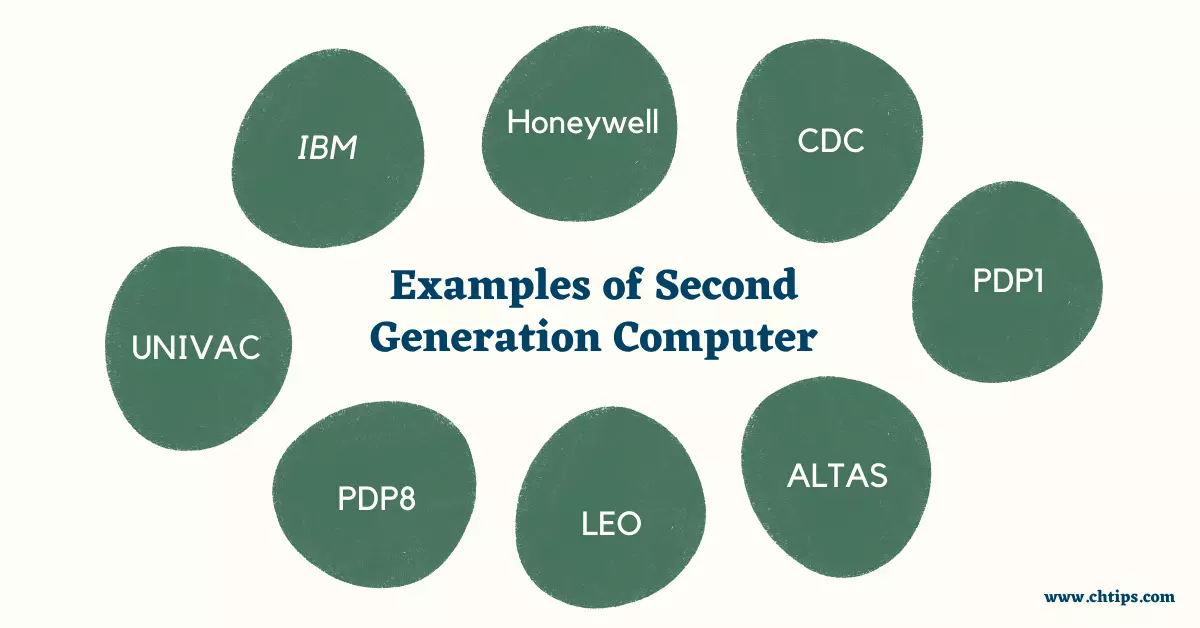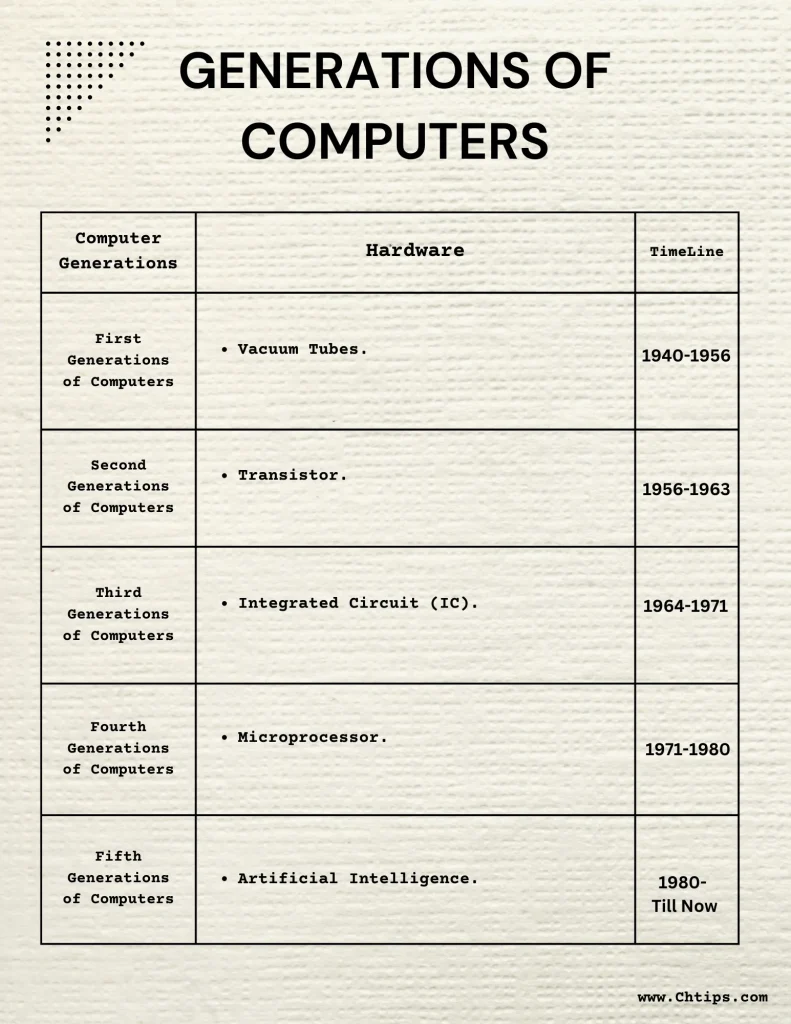The Five Generations of Computers can be described as the overall development of computer technology respective to their size, power, memory, cost, and application.
Compared to the first generations of the computer, modern-day computers are faster, smarter, stronger, and cheaper and can store a huge amount of data.
Due to vast development and huge improvements of the modern computer, the work of mankind has been made much more accessible than ever before with the development of high-speed and advanced processors (CPU).
The speed of computers has increased drastically, and the modern-day personal computer requires less space for its installation.
Prior to some time, they were differentiated by their development in hardware technology.
Still, nowadays, they are classified by the development of hardware technology and the software applications used in them.
As software and applications play an important role in the functions of computers, we cannot deny the factor of software and application in the Advancement of computer technology.

Related Articles
- Advantages and Disadvantages of Fifth Generations of Computer
- Advantages and Disadvantages of First Generation Computer
- Characteristics and Features of Third Generation Computer
- 10 Characteristics and Features of Second Generation Computer
- Advantages and Disadvantages of Third Generation of Computers
- Classification of Computer According to Purpose, Size, Types and Uses
- Fifth Generation Computers are Based on?
- Fourth Generation of Computers
- Differences Between Second Generation and Third Generation Computer
The Five Generations of Computer in Tabular Form
| # | Computer Generations | Timeline | Hardware |
| 1 | First Generation of Computer | 1940-1956 | Vacuum Tubes |
| 2 | Second Generation of Computer | 1956-1963 | Transistor |
| 3 | Third Generation of Computer | 1964-1971 | Integrated Circuit (IC) |
| 4 | Fourth Generation of Computer | 1971-1980 | Microprocessor |
| 5 | Fifth Generation of Computer | 1980- Till Now | Artificial Intelligence |
First Generation of Computer (1940-1956)
The First Generation of computers used vacuum tubes in their hardware circuit and magnetic drums for their memory.
They were gigantic in size and were kept in an enormous room.
The heat or warmth generated by them was high in numbers, therefore malfunctioning or breaking down on some occasions, as well as their consumption and utilization of electricity and power was very massive.
A vacuum tube was a substantial delicate glass device that utilized fibres as a source of electrons and could control intensified electronic signals.
They were able to easily understand low-level programming languages; therefore, they relied on “Machine Language” so they could take care of or solve one operation or problem and issues at a single time.
The input was given to them with the assistance and help of punch cards and paper tapes, and gathered outputs on “printouts”.
Following are the Example of First Generation of Computer
| ENIAC | Electronic Numerical Integrator and Computer. |
| EDVAC | Electronic Discrete Variable Automatic Computer |
| UNIVAC 1 | Universal Automatic Computer 1 |
Second Generation of Computers (1956-1963)
The second generation of computers utilized “Transistors” instead of huge vacuum tubes.
The transistor was designed and invented in 1947 by three physicians Bardeen, Brattain, and Shockley.
The Transistor was better than vacuum tubes.
They allowed PCs to become smaller, faster, cheaper, and produced less energy,
Energy consumption was far lower than the first generation of computers. They were exceptionally dependable and reliable.
They were damaged often as the transistor generated heat and were very warm in nature, but it was considerably less than vacuum tubes.
Still, it was a step ahead in development compared to vacuum tubes.
The second generation of computers used high-level Programming languages as well as binary and assembly languages.
They used languages like FORTRAN (Formula Translator ) AND COBOL (Common Business Oriented Language).
They used punched cards and paper tapes for input and Printouts for Outputs.
They were also the first computers that stored instruction and information in their memory using magnetic core technology.
Computer Generations were utilized as a part of the industry of nuclear energy, and their examples are
- IBM 7030/7094
- Honeywell 400 Philco

Related Articles
- A Brief History of Computer
- What are Input Devices of Computer
- 10 Uses of Computer in Different Fields With Pictures
- What are Output Devices of Computer
- What is a Computer Virus?
- Advantages and Disadvantages of C Language
- Features of Fifth Generation Computer
- Differences Between First and Second Generation of Computers
- Which Generation of Computer is Still Under Development
- Differences Between Third and fourth Generation of Computers
- Advantages and Disadvantages of Fourth Generations of Computer
Third Generation of Computers (1964-1971)
The Third Generation of Computers used Integrated circuits (IC) rather than vacuum tubes and transistors. Jack Kilby 1958 created the Integrated Circuit.
Several other components and segments, like Transistors, resistors, and capacitors, were used in a single silicon chip and were called “Semiconductors”.
Which drastically improved and enhanced the speed, reliability, efficiency, and dependability.
The Second Generation of computers used punched cards and paper tapes for input.
While the Third Generation used keyboards and monitors, the operating system was built to help them interact and communicate.
The operating system allowed many applications to run simultaneously with the help of a central program with Computer memory.
1. Small Scale Integration (SSI)
Just 10 to 20 component like Transistor, Capacitor, and Resistor was Integrated with the “Integrated Circuit” (IC) Within a Silicon Chip.
2. Medium Scale Integration (MSI)
More than 100 components were integrated into the silicon chip. Integrated Circuit (IC) Was much better compared to Vacuum tubes and Transistors.
It was broadly used at that time since it converted computers into smaller, less expensive, efficient, proficient, and reliable ones.
The energy produced by them was significantly less compared to vacuum tubes and transistors.
The energy consumption was less compared to the second generation of Personal computers.
They had a principal or main memory capacity and were well equipped to store data inside the scope of 10 MB And a magnetic disk storing a few MB of data.
It used binary, assembly, and high-level languages like FORTRAN, COBOL, PASCAL, and BASIC.
Example :: PDP8,IBM360,PDP11.
Fourth Generations of Computers ( 1971-To Present Day)
The Fourth Generations of computers used a “Microprocessor” Instead of vacuum tubes and transistors. The PC that uses Microprocessor [CPU] is called as “Micro-Computers”.
Microprocessors or Microchips are developed using Large-scale Integration.
- LSI:: (Large Scale Integration)
- LSI Stands for Large Scale Integration. This innovative technology is where hundreds and thousands of parts, such as Transistors, capacitors, and resistors, are integrated into a small silicon chip.
- VLSI:: (Very Large Scale Integration)
- ULSI:: (Ultra Large Scale Integration)
This technology integrates hundreds and thousands of components into the silicon chip. The first main Microprocessor was produced by Intel in 1971.
Which had all central processing units, memory, and output controls. Further, many developments came into existence, such as the IBM computer.
Which came in 1981, and after a couple of years, Apple came with Macintosh Microprocessors in 1984.
The Awesome processing power incorporated in a tiny silicon chip significantly reduced the cost, size, and energy consumption, and the heat they produced reduced enormously.
Importantly as the size and the handling processing power were integrated into a small chip, it became very easy to connect this types of computers to other computers and, more importantly,
They used a new feature called GUI (Graphical User Interface ); with the help of this feature, users felt free to use the mouse and other pointing devices and gadgets.
Examples
- Intel Pentium
- AMD
- Apple II
You May Also Like Reading
- What is Dos Operating System
- What are Basic Dos Commands
- Five Generations of Computer in Hindi
- How to Reset BIOS Password
- Importance of Teachers in Students Life
- What is USB Pendrive
- Computer Basic Tutorials
Fifth Generations of Computers (Present and Beyond)
The Fifth generation of computers is in a development face that uses AI (Artificial Intelligence).
This types of computer will be very smart. They will make their own decision.
When given a condition, they will also have the ability to reason as human beings do with parallel processing and superconductors working together to develop “Artificial Intelligence“.
They will communicate with humans with the help of languages, pictures, sign language, speech, and writing.
They will have a huge amount of knowledge stored in their memory so that they can respond to the inputs given by humans and take appropriate action whenever necessary.
They will be extremely intelligent machines. You can get an idea of (AI) used in the Voice recognition system.
Many big Internet companies have started their research on AI, and within a few years, they will be able to come up with advanced and innovative techniques and ideas.
Google has almost completed there work on AI which will be responsible for accurate search results [SERP].
Example
- PARAM 10000
- INTEL IPSC-1
Useful Video On Computer Generations
Explain 5 Generations of Computers Using Image

Five Generations of Computer PDF Download
| Computer Generations 1st to 5th PDF Download | Download |
Frequently Asked Questions [FAQs] On Computer Generations
What are the 6 Generations of Computers?
First Generation (1940 – 1956)
Second Generation (1956 – 1963)
Third Generation (1964 – 1971)
Fourth Generation (1971 – 2010)
Fifth Generation (2010 to Present)
Sixth Generation (Future Generations of Computers)
Who is Father of Computer
Charles Babbage is considered as “Father of Computer”.
Fastest Computers in All Generations
Super Computer is the fastest computer.
How Many Types of Computers Are There?
Three types of computers.
Analog.
Digital.
Hybrid.
Who is the Father of AI?
John McCarthy
First Known Computer
Antikythera Mechanism is the oldest computer.
Get In Touch
I have also written and compiled some articles on computers and telecommunications, and please go through them.
I hope you will like reading it.
All the questions and queries related to Five Generations of Computer System are answered here.
If you have any questions about Computer Generations.
Don’t hesitate to contact me, and if you feel to add, remove or update anything from the article, please let me know in the comment section or via email.
I will be more than happy to update the article. I am always ready to correct myself.
Please share this article with your friends and colleagues; this motivates me to write more related topics.
!!! Thank You For Reading !! GOD BLESS